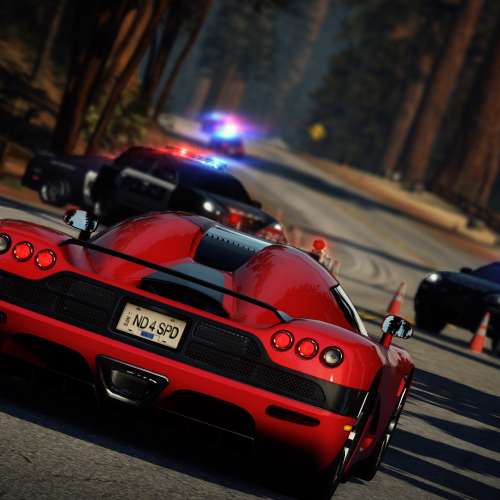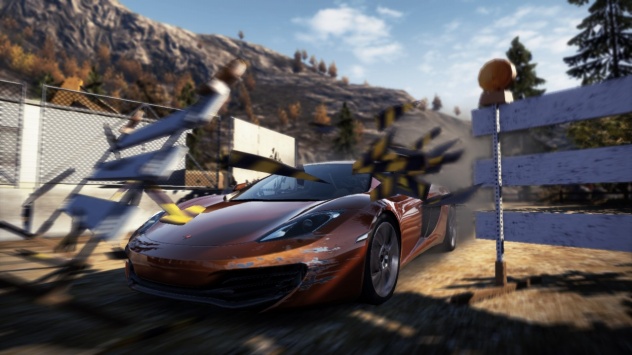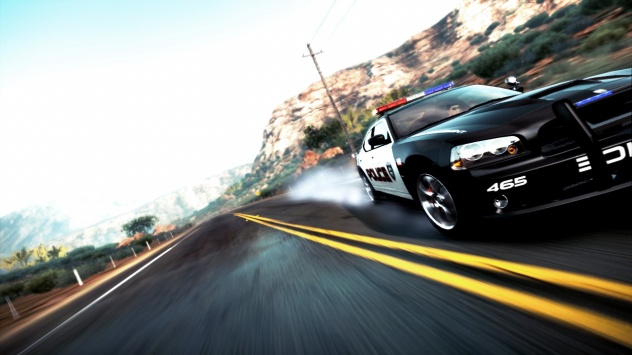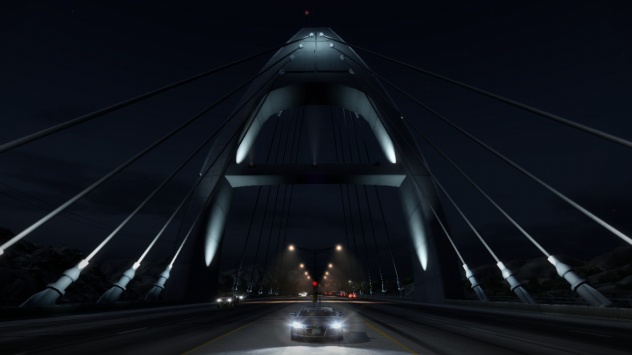
I have a confession to make. I’ve never played a Need for Speed game. The early games passed me by, and I had no interest in the ‘Fast and Furious’ stylings of many of the more recent games. On the other had, I have played every single Burnout game to death, and am still playing Burnout Paradise almost three years later.
So when the news hit earlier this year that Criterion had made the switch from Burnout to Need for Speed, it certainly piqued my interest, but what were we going to end up with? I was hoping for another Burnout in all but name, but was I going to be disappointed?
I needn’t have worried.
The setting here is that the police force of the fictional Seacrest County, the SCPD, are engaged in an ever escalating war against illegal racers on their patch. So much so that they are equipping themselves with the fastest cars money can buy so they can beat the racers at their own game. But it is the cars that are the stars of this game, no cut-scenes, no story playing out explaining your actions – it’s simply cops and racers in the fastest cars around beating seven bells out of each other.
If you are a fan of the pre-Paradise Burnouts, then that is essentially what you are getting here, but with a cop/racer twist. Pick a Racer or Cop event from a map, pick a car, watch a brief semi-skippable introduction (more on that later), then BAM, you’re barrelling down the picturesque Seacrest County lanes and freeways.
Unlike Paradise’s locked 60fps, NFSHP runs at a steady 30. Whilst that may be disappointing to some, the lower framerate has a major impact on the graphics – the game is simply gorgeous, and the world that Criterion (with help from DICE) have created takes in every type of scenery you can think of. From beaches to forests, deserts to snow-capped mountains, and you get some stunning thunderstorms too.
The main driving mechanics are, again, similar to Burnout. You earn boost based on how you drive. Racers earn it by driving recklessly – against oncoming traffic, near misses, slipstreaming, drifting etc. The Police also earn boost from drifting, and slipstreaming, but as they are expected to respect the rules of the road a little more, they don’t get anything for oncoming traffic, but their boost is more powerful.
The handling is a little less forgiving than Burnout, but certainly nowhere near simulation territory – you’re drifting 200mph supercars round blind bends, for instance. The drifting mechanic is simple to use as well, and before long you’re feathering the accelerator to hold your drift round a curve like a pro.

Each “side” has it’s own career progression; you earn XP (sorry, “bounty”) in every event depending on how well you do, no matter how many times you’ve played it before. There are 5 classes of vehicle and new cars for each class and new equipment levels are unlocked thick and fast as you play.
Hang on, equipment? Did I forget to mention that? This is where the game makes a departure from its Burnout roots but only comes into play on events where cops and racers mix. Each side has 4 pieces of equipment available to them, each mapped to a direction on the d-pad. The exact selection and quantity varies from event to event and is not replenishable mid-race. This adds a level of strategy, as some equipment works best in specific situations. Should you use it now, or save it for later?
As a cop, you have spike strips you can drop behind to take a racer out, an EMP blast to damage them, call in a road block ahead of the race, and finally call helicopter support to pursue the race leader and drop more spike strips in front of him. Racers also have EMPs and spike strips, but they also have a jammer (to block EMPs and, if you time it right, helicopter tracking), and a turbo that is far faster than the normal ‘boost’ and can be used aggressively to ram the police, or to aid your escape. Each piece of equipment has three levels as well and enhanced versions are also unlocked as you progress through the ranks – for example, single spike strips, become longer spike strips, which become double spike strips.
There are several different event types on the map, yet the eponymous Hot Pursuit events are what the game is all about – cops pursuing racers. You may be the cop trying to “shut down” the race – by wrecking all the individual racers, or the racer trying to get to the finish line in first place if possible, fighting off the cops on the way.
Unfortunately, despite the name, these events only seem to make up about half of the game. Other event types are straightforward races (for the racers), or ‘rapid response’ (for the SCPD). Some of these serve as tasters, giving you a sneak preview of some of the top-end cars that you won’t unlock for ages. Whilst it is great to try these cars out extra early, I found these events the least enjoyable. It’s just you on your own, getting to a destination on a fixed route as quickly as possible, with, for the SCPD, time penalties for collisions with barriers and other vehicles. For me, these “be careful with the new car” events don’t seem to sit well alongside the “ram that idiot off the road” ones.

In between events you can enter free-roam mode and take any car you have unlocked for a spin around the county. It has been claimed that the map is four times the size of Paradise City, but it is difficult to get a feel for this when you are just selecting an event from a map. Free-roam however really brings home the scale of the world that Criterion have built here. Having said that, other than exploring there is very little to do apart from just driving around, enjoying the scenery and familiarising yourself with the roads and shortcuts. It felt to me more like a container for future DLC modes.
What it IS useful for is Photo mode. Just hit Start at any time, pick Photo Mode from the menu, and you are free to position the camera freely around your car, alter the camera settings, motion blur, depth of field etc, and can pull of some quite stunning shots. When you’re happy with your creation, take the “dreamshot” and a HD photo will be saved in Autolog for you and shared with your friends – in fact, all the images in this review were taken ourselves using it.
Sadly there is no splitscreen or local multiplayer mode, and the online modes in Hot Pursuit are fairly limited. Like Paradise, you are limited to 8 players, and for game types you have a choice of three modes. The two main modes are straightforward racing and Hot Pursuit. Public games autobalance the sides to keep things even, but in private games everyone is free to choose whether they are racer or cop. So if 7 of you want to be cops chasing down a solitary racer, then you can. These events are always ‘fixed route’ events off the single player map, with alternate routes and certain shortcuts often walled off with flashy neon chevrons. Despite the restrictions here, the game mode itself is great fun and often totally unpredictable. Whilst there is no host migration, at least the host can freely switch game modes and car classes on the fly without having to disband the party.
The other online mode is Interceptor and is for 2 players only. One solitary cop chasing a lone racer across the open world map. The cop needs to keep close to the racer and take him down; the racer wins by putting enough distance between them and the cop for a set amount of time. Having the freedom to go anywhere really livens up this game mode – all roads and shortcuts are open so there is plenty of opportunity for doubling back on yourself and trying to deceive your pursuer.
One of the best things about Burnout Paradise was how tightly the online multiplayer was integrated into the game. The single player game was the multiplayer, Paradise City was both lobby and game and even while you were just messing about, the time taken to drive every street was recorded in the background while you played and compared with your friends.
While Hot Pursuit seems have taken a step backwards with the absence of multiplayer free roam and the return to selecting events off the map, Criterion have taken their background comparison engine that worked so well in Paradise, integrated it into every screen and every mode in the game and given it a spangly new name: Autolog.
Every event you race, Autolog tracks your time and compares it to your friends. Not only that, it tells you the car they used and how many goes it took them to get that time. So maybe John beat you by 5 seconds, but if you got your time on your first go and he took 37 attempts to beat you, you know you have the moral high ground. Of course, when you beat a friend’s time, the moral high ground goes out the window as you post both your time and some suitably insulting message on their “Speedwall” – the equivalent of Facebook’s wall – which they will see next time they play.
It is this seemingly simple evolution of the online leaderboard that is the true heart of Autolog. While some may lament Criterion’s apparent backward step in terms on multiplayer modes, Autolog directs you to a new form of multiplayer – a totally asynchronous one.
Yes other games like Blur have done the whole leaderboard/rival thing, but Autolog is a real evolution of the concept. You don’t need to check the events yourself, every time you play, Autolog will give you recommendations based on what your friends have done recently. Maybe someone has beaten one of your times, maybe they have tried an event recently that you haven’t. A single press of the right trigger on the Autolog Recommends screen will get you playing the suggested event in seconds. And with being able to log into the Autolog website to check what your friends are doing, and an Autolog iPhone app recently being teased, there will soon be no escaping it.

Despite all the great elements of the game, there are some little annoyances. As briefly mentioned, Hot Pursuit doesn’t seem to have enough Hot Pursuit. Save the timed races for more serious games, we want action! Also, the map is a little clunky. Given the size of it, you can understand why they haven’t used Burnout’s ‘drive to the event’ model, but the map isn’t brilliantly structured. There are around 10 locations each with a separate list of SCPD and Racers events. Given how well Autolog directs you to challenge and beat your friends, a little more direction in the single player would have been welcome.
There is one other minor thing that really bugs me – a little scene-setting movie plays at the start of the event with a tantalising “Skip” button… which if you press, it carries on playing half of the scene with the message “skipping.” Obviously the movie is here to disguise the level loading, but there is no point in putting a skip button up until you can actually skip! It’s a minor niggle but it bugs me every single time I play, and with the attention to detail lavished on the rest of the game, it seems an odd oversight.
Ongoing support for the game has already begun, with three car packs already available – the obligatory “time saver” car unlock packs for cops and racers, and the SCPD Rebel pack (racer versions of 7 existing cop-specific cars), each costing £1.99. A free 3 car pack has also been promised if EA get 1 million views of the launch trailer by 12th December. A more comprehensive “Super Sport Pack” has been announced as well which contains new cars, new events and new trophies/achievements. If Criterion support this game half as much as they did with Paradise, then we will probably see some more online modes at some point as well.
So in summary, Hot Pursuit is a superb arcade racer, combining the real cars and the police chases from Need for Speed, the arcade racing and crashing action from Burnout, and seamless online integration via Autolog. When I’m not playing Hot Pursuit, I’m thinking about playing Hot Pursuit. If you’re thinking about playing Hot Pursuit, then I recommend you stop thinking and buy it. Now.


A great review for a jaw-droppingly good game.
“There is one other minor thing that really bugs me
It really is a great game, I’m glad I bought it when I did. The Autolog adds a painful level of addiction, and like yourself it’s only GT5 that’s stopping me living on Hot Pursuit!